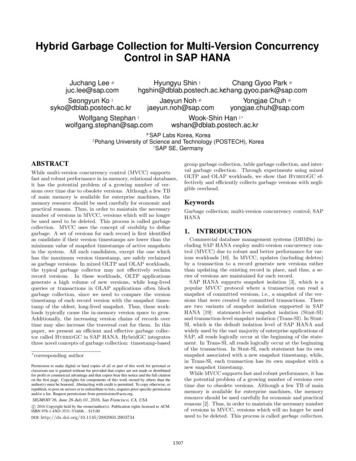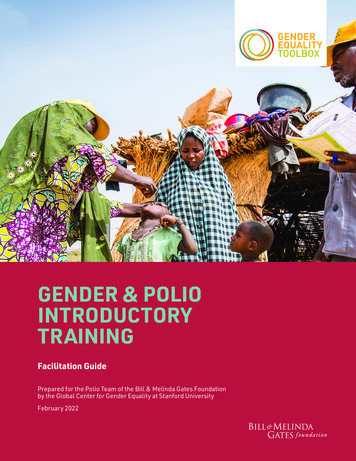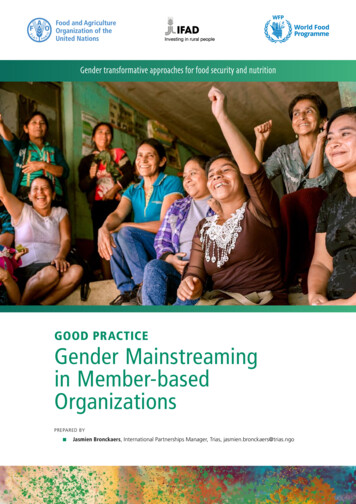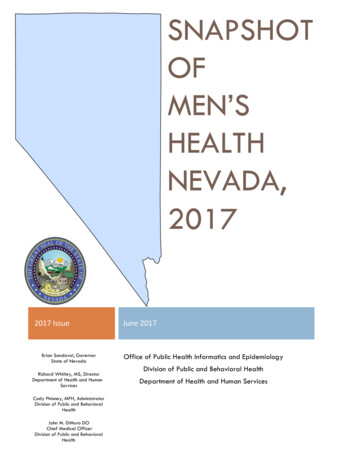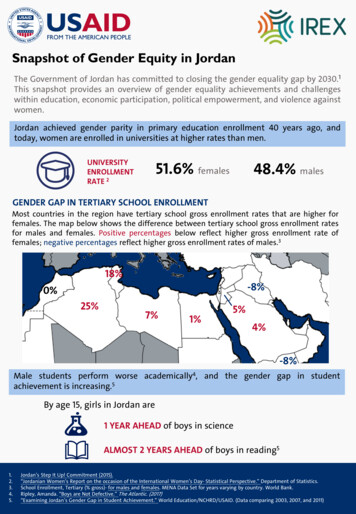
Transcription
Snapshot of Gender Equity in JordanThe Government of Jordan has committed to closing the gender equality gap by 2030.1This snapshot provides an overview of gender equality achievements and challengeswithin education, economic participation, political empowerment, and violence againstwomen.Jordan achieved gender parity in primary education enrollment 40 years ago, andtoday, women are enrolled in universities at higher rates than men.UNIVERSITYENROLLMENTRATE 251.6% females48.4% malesGENDER GAP IN TERTIARY SCHOOL ENROLLMENTMost countries in the region have tertiary school gross enrollment rates that are higher forfemales. The map below shows the difference between tertiary school gross enrollment ratesfor males and females. Positive percentages below reflect higher gross enrollment rate offemales; negative percentages reflect higher gross enrollment rates of males.318%-8%0%25%7%1%5%4%-8%Male students perform worse academically4, and the gender gap in studentachievement is increasing.5By age 15, girls in Jordan are1 YEAR AHEAD of boys in scienceALMOST 2 YEARS AHEAD of boys in reading51.2.3.4.5.Jordan’s Step It Up! Commitment (2015).“Jordanian Women’s Report on the occasion of the International Women’s Day- Statistical Perspective.” Department of Statistics.School Enrollment, Tertiary (% gross)- for males and females. MENA Data Set for years varying by country. World Bank.Ripley, Amanda. “Boys are Not Defective.” The Atlantic. (2017)“Examining Jordan’s Gender Gap in Student Achievement.” World Education/NCHRD/USAID. (Data comparing 2003, 2007, and 2011)
Females are less likely to study and enter science, technology, engineering, and math(STEM) fields, even though they outperform males academically.PASSAGE RATES OFSECONDARY SCHOOLSCIENTIFIC EXAM677% females63.5% males35%30%TECHNOLOGY &COMPUTINGMAJORS INCOLLEGES7ENGINEERINGMAJORS INCOLLEGES765%70%malesfemalesDespite the high number of educated women, women’s economic participation inJordan is among the lowest globally and in the region.FEMALE LABOR FORCE PARTICIPATION RATE 824%12%21%15%34%22%14%22%6%LABOR FORCEPARTICIPATION96.7.8.9.14% women54.8% menMinistry of Education. The Statistical Report for the School Year (2018/2019).Ministry of Education. Annual Statistics Report. (2017/2018)Labor force participation rate, female – (modeled ILO estimates)- MENA Data Set for 2019. The World Bank“Unemployment Rates during the first Quarter of 2020.” Department of Statistics.
Jordanian women make up almost half of the public workforce, but 81% of womenworking in the public sector are concentrated in the education and health ION OFFEMALE PUBLICSECTOREMPLOYEES BYSECTOR1056%19%14%HealthEducation67%Other SectorsmalesFurthermore, women in the public sector are underrepresented in leadership and decisionmaking positions.WOMEN HOLD7% of decision-making positions38% of leadership positionsIN THE PUBLIC SECTOR11Nearly 1 in 2 women are working informally, not protected by the Labor Law. 31% of formal private sector employees arewomen. Formal private sector workersreceive Social Security, which also covers payduring maternity leave.46% of women work informally12Working through unregulated employment increases the likelihood of the following: No written contract Longer than 8-hour days Harassment Less than minimum wage No paid leave, including maternity leave No social security contributionsThere are few women in business leadership positions, and women have less access toand control over financial resources.3.8% of firms have femalemajority ownership14ACCESS TO ACCOUNTWITH A FINANCIALINSTITUTION 152.4% of firms have femaletop managers 1426.6% women55.5% menBanking policies are written to be gender neutral, but in practice, a man may receive a loanwithout a spousal guarantee and with less collateral compared to a woman seeking the samevalue loan. Women often resort to collaborative savings methods and borrowing from family.10.11.12.13.14.15.Government employees according to gender and educational level. Data Set for 2017. Department of Statistics.Arabic infographic from study examining the situation of women in the public section. USAID Takamol in partnership with Ministry of PublicSector Development. (2015).Aita, Samir. “Arab Watch on Economic and Social Rights 2016: Informal Labor: Reality and Rights.” Arab NGO Network for Development(ANND)Percentage of private sector employees registered with Social Security, according to Social Security Corporation’s Annual Report (2018), p48.“Global Gender Gap Report.” World Economic Forum (2020), p204.“Global Financial Inclusion Dataset. The World Bank (2017). See Indicator Name: Financial institution account , female(% age 15 ) (fin1.t.a.2)(country: Jordan)
Although 71% of Jordanians express support for equal rights and treatment for menand women, social norms emphasize women’s roles inside the home and men’s role asprimary breadwinners and leaders. 16ACCORDING TO A SURVEY CONDUCTED BY USAID TAKAMOL IN 2017,76%agree with the statement when jobs are scarce, men shouldhave more rights to jobs than women.65%agree with the statement that men make better politicalleaders.Although women are generally accepted as political leaders, they are not viewed as capable asmen in political office. In 2003, Jordan introduced a quota for women in Parliament that issupporting women to reach higher positions of political leadership and helping to changethese perceptions.Today, the following women’s quotas are in place for each level of L COUNCILSLOCAL COUNCILS15 elected seats10% of elected seats and 5% of appointed seats25% of elected seats1 elected seat70% of Jordanians support the quotaIN THE 2016 PARLIAMENTARY ELECTIONS,252 out of 1252 candidates were women 185 out of 20 Parliament seats won by women17IN THE PRIME MINISTER’S CABINET,4 of the 28 cabinetare womenmembers20were secured outside the quota 1915.3%16. “National Gender Survey”. USAID Takamol. Data set from 2017. Similar results are found within the “2018 USAID Jordan General PopulationSurvey.”17. Thomas, Kathrin. Women’s Rights in the Middle East and North Africa. Arab Barometer August 2019.18. RASED. “Jordanian Women’s Attitudes Towards 2016 Parliamentary Elections.” Al Hayat Center for Civil Society Development-RASEDSeptember 2016.19. Haddadin, Samar. “ 15.3% Women’s representation in the House and Senate, and the Kingdom Jumped 5 places in Ranking” Alrai Newspaper,September 2016.20 Prime Minister Omar Razzaz’s 3rd cabinet (October 2019 – September 2020): Rami Al Samhouri .“It's time for women in Jordan to have betterrepresentation in politics and decision making” UN Women-Arab States. October 2019; “Royal Decree approves reshuffle as Cabinet sees ninenew minister” Jordan Times. October 2019.
Women in Jordan face various forms of Violence Against Women (VAW) that can bemitigated through stronger legislation and improved response mechanisms.CHILD MARRIAGE10%In 2019, 1 in 10 marriage contracts issued in Jordan involved women belowthe age of 18. 21The legal age of marriage is 18 years old, but judges may approvemarriages for children 16 years of age and over.Child marriages are concentrated in governorates with high numbersof Syrian refugees. 4 out of every 10 Syrian females married in 2015were under the age of 18. 22Child brides are more likely to suffer injuries as a result of violence from their husband. 2329.9%of bridesmarried before 18experienced injuries20.5%of bridesmarriedafter18experienced injuriesDOMESTIC VIOLENCEWhen the Family Protection Department was established in 1998 to respond to instances ofviolence within the family, it received 275 cases. 24 Since then, increased awareness about theDepartment’s role has resulted in increased reporting of cases.ACCORDING TOFAMILY PROTECTIONDEPARTMENT DATA 25In 2018, 11,923 domestic violence cases were reported.In the first half of 2019, 7,228 domestic violence cases werereported.A culture of silence and shame contributes to domestic violence being kept within the family.Placing blame and responsibility on survivors perpetuates situations of abuse.46% of ever-married women and 69% of all men ages 15-49 agree that there arecircumstances in which wife beating is justified.26Only 1 in 5 women who have experienced physical or spousal sexual violencehave sought help to stop the violence. 26The most common source sought for help is a woman’s own family (77%) orher husband’s family (21%). 26Femicide by family members remain a major issue, with estimates of around 20 deaths peryear. 27 So far in 2020, at least 13 women have been murdered by family members.21. ”Annual Report- 2019”. Supreme Judge Department.22. Policy Brief: Child Marriage in Jordan. Higher Population Council (2017).23. A Qualitative Study on the Underlying Social Norms and Economic Causes that Lead to Child Marriage in Jordan. UNICEF(2019)24. Kayed, Maram. “7000 cases of domestic violence reported in 2019.” Jordan Times.25. Arab Women’s Legal Network Mapping Study of the Protection Against Domestic Violence Law Services (USAID Takamol 2020).26. Population and Family Health Survey 2017- 2018. Department of Statistics.27. Thompson, Rosie-Lyse. “Jordanian women imprisoned in name of family honor.” Reuters (2017).
Snapshot of Gender Equity in Jordan. Jordan achieved gender parity in primary education enrollment 40 years ago, and today, women are enrolled in universities at higher rates than men. 51.6% . females. 48.4% . males. UNIVERSITY ENROLLMENT RATE . 2. Male students perform worse academically. 4, and the gender gap in student achievement is .



